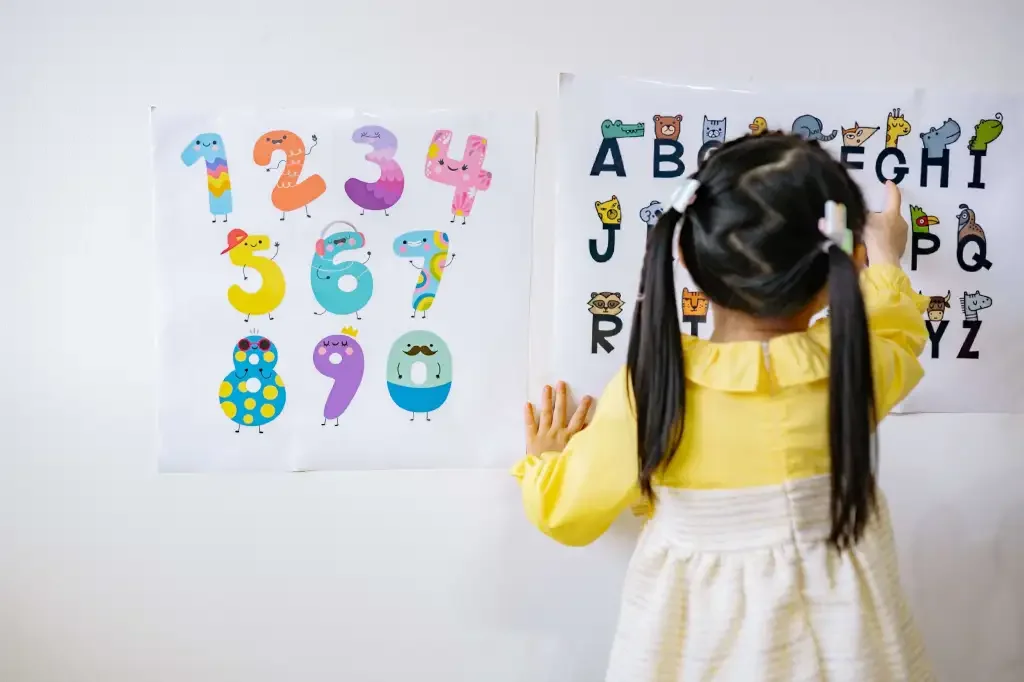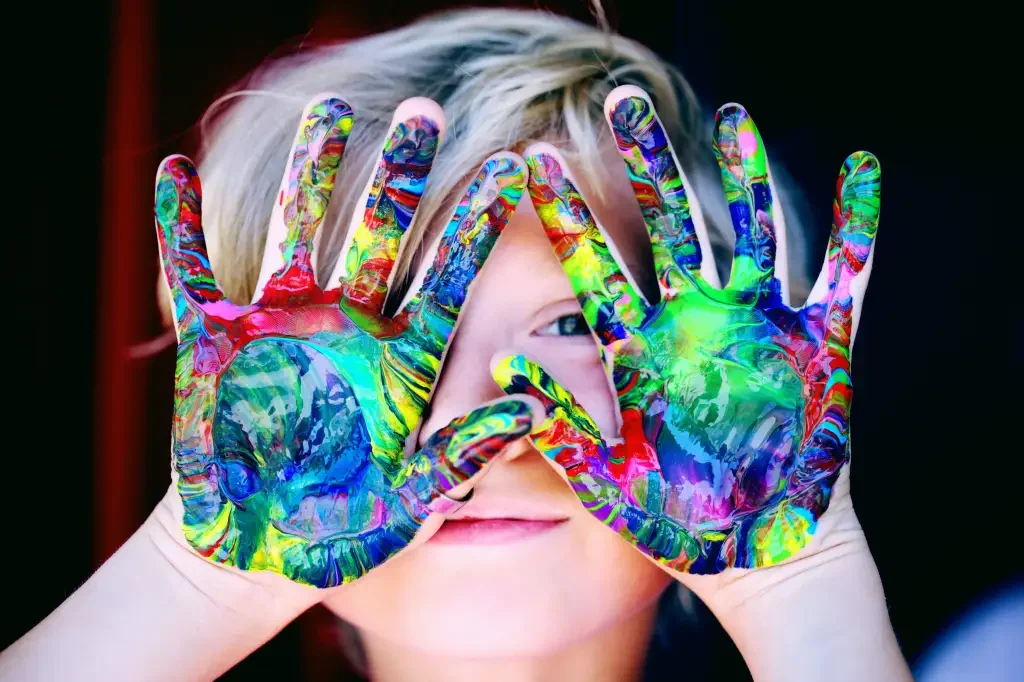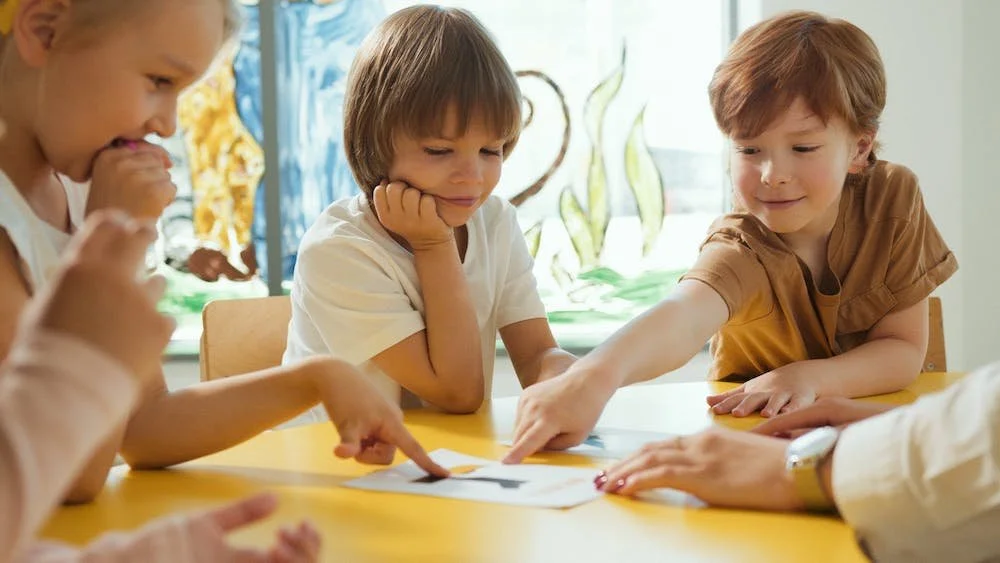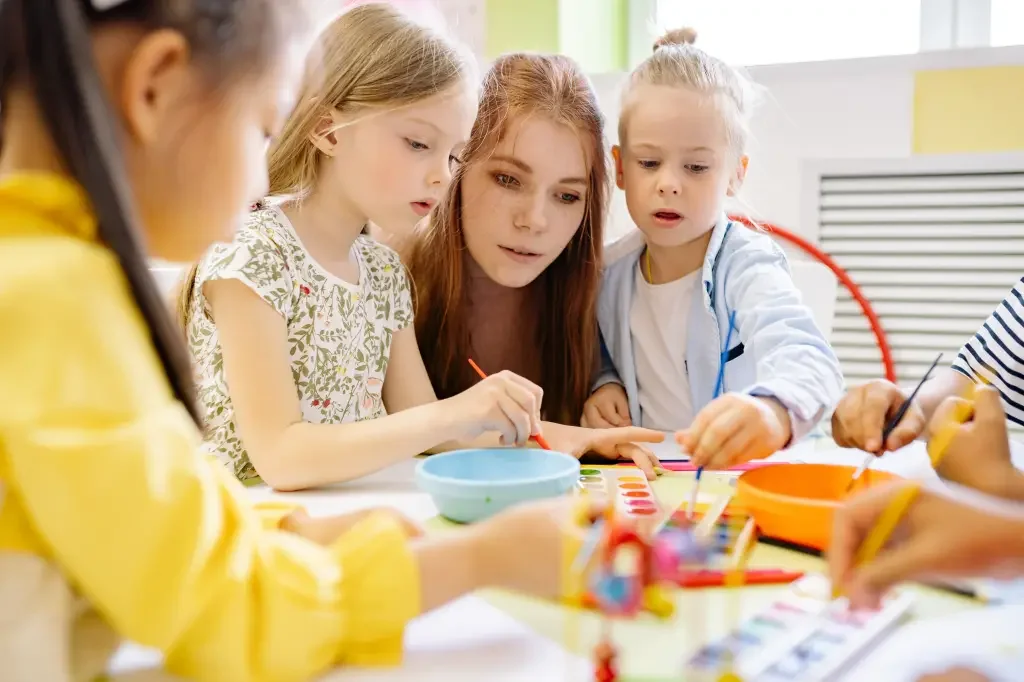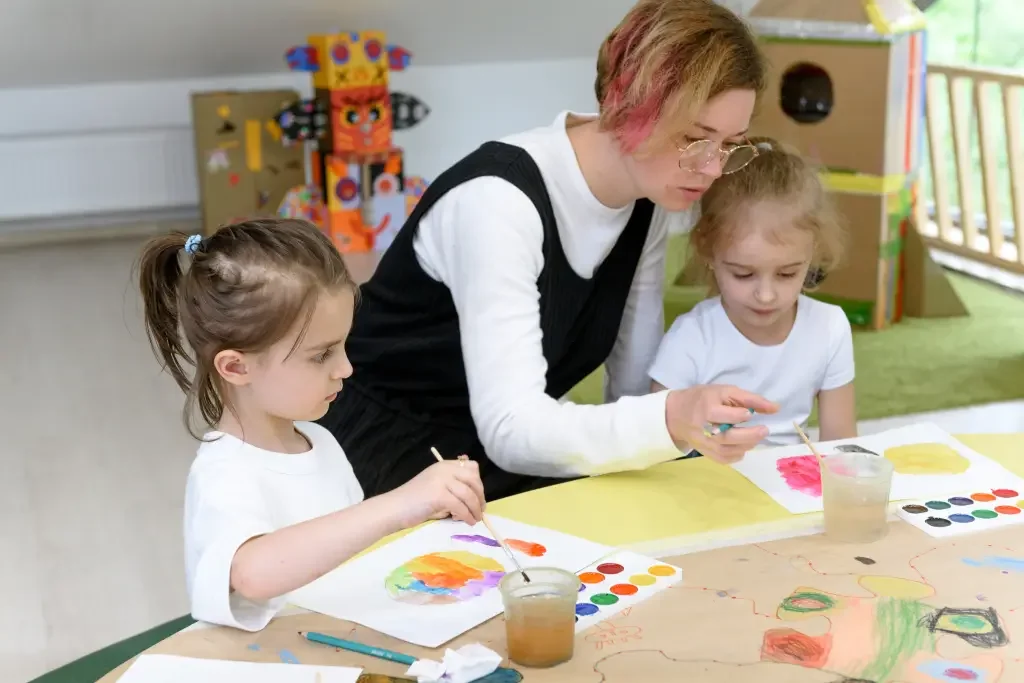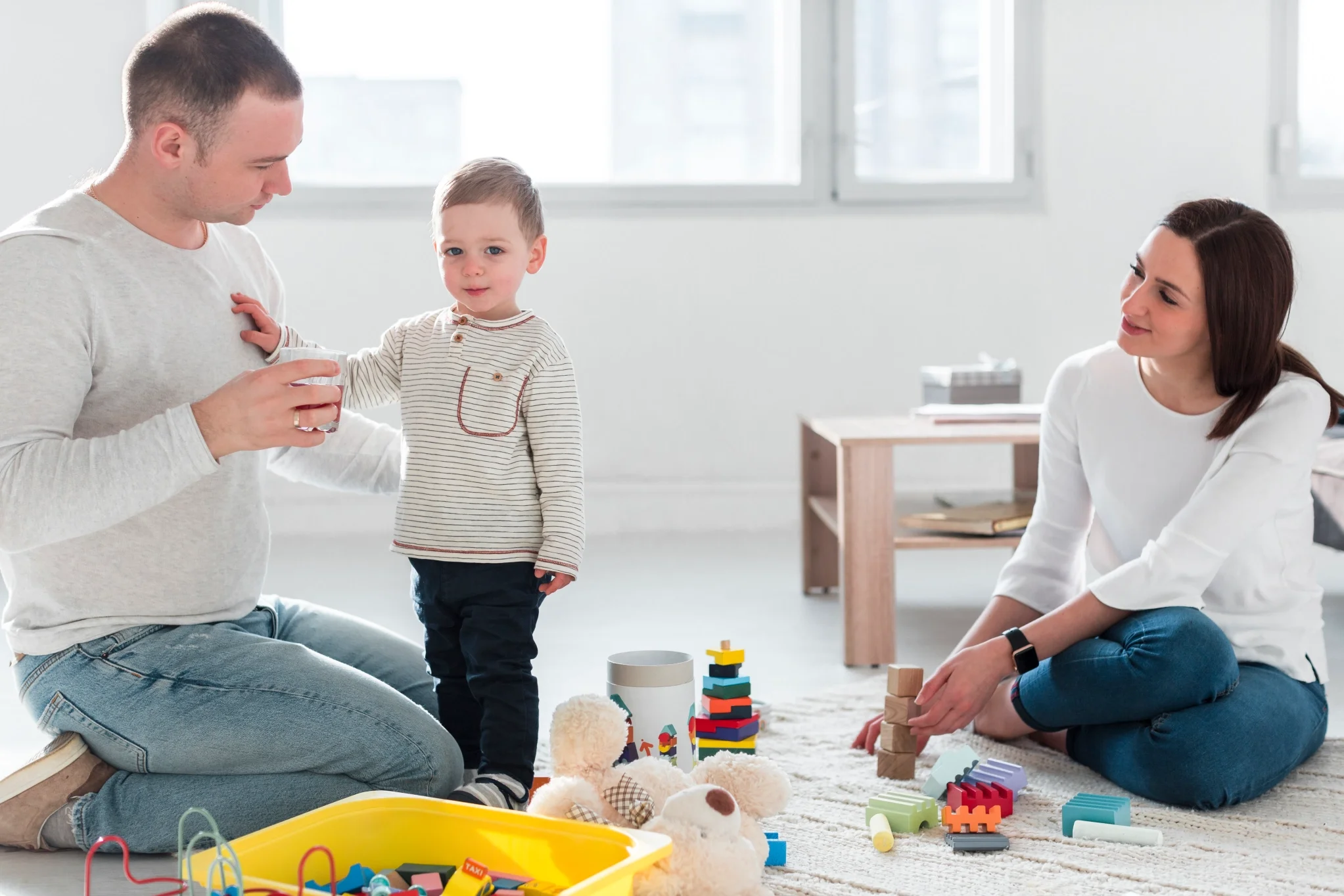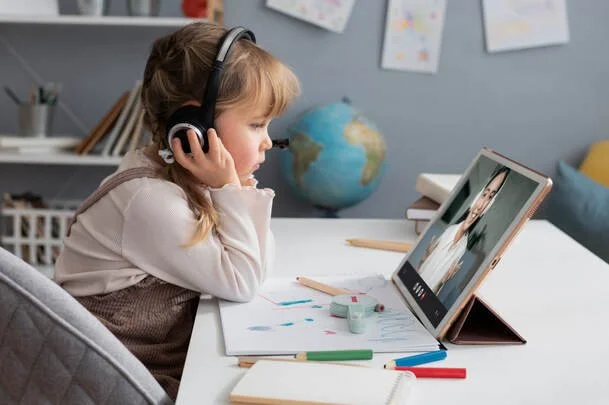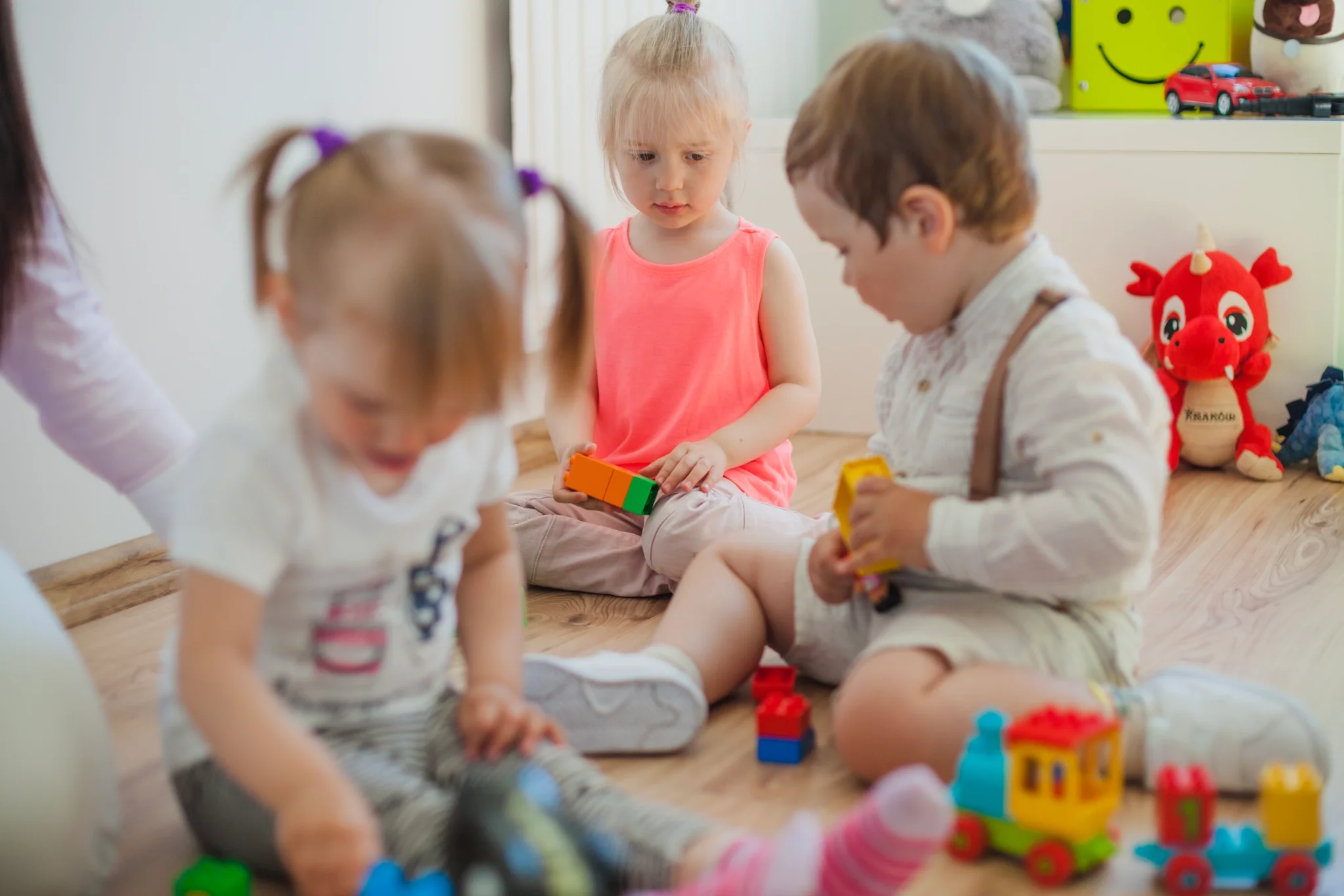How Montessori Math Materials Build True Number Sense
Math doesn’t have to feel intimidating to young children. In a Montessori preschool environment, numbers become tangible through hands-on exploration. Instead of memorizing symbols or repeating formulas, students use beads, rods, and counters to see and feel mathematical relationships. This direct experience builds confidence and understanding far earlier than rote instruction ever could.
The Power of Concrete Learning
When children manipulate golden beads to represent units, tens, hundreds, and thousands, abstract numbers suddenly gain meaning. They can see what “ten times ten” looks like, touch it, and arrange it on a mat. This sensory process activates both motor and reasoning centers in the brain, creating durable connections between quantity and symbol.
In a Montessori preschool program, math is a language to explore. Students match numerals to bead quantities, sequence patterns, and eventually record results independently. Each step connects to the next in a logical progression that reinforces accuracy through discovery.
A Developmental Path Toward Abstraction
Traditional math lessons often skip directly to symbols, leaving many students unsure of what those numbers truly represent. Montessori classrooms take the opposite approach. By first internalizing patterns through movement and repetition, children develop an intuitive grasp of numerical relationships. They are not told that four plus four equals eight—they see it and build it with their own hands.
This developmental sequence leads naturally toward abstraction. Once a child has mastered concrete tools like number rods and bead chains, they can easily visualize numbers in their mind. That ability, known as “mental representation,” is what researchers call true number sense.
Recent research in Education and Culture shows that when manipulatives are used intentionally, children move from concrete exploration to abstract understanding. The study finds that math toolkits which enable children to physically engage with numbers support stronger reasoning and connection-making.
Encouraging Precision and Confidence
Montessori math materials also teach precision through control of error. If a quantity doesn’t match its numeral, the child sees and corrects it without teacher intervention. This independence strengthens problem-solving skills and builds genuine confidence. Teachers serve as quiet guides, ensuring each child progresses at their own pace without pressure or competition.
Because math materials are self-correcting, frustration remains low while concentration grows. The rhythm of hands-on learning creates an internal sense of order that helps children apply logic to new challenges both inside and outside the classroom.
For a deeper look at how Montessori teachers guide learning rather than direct it, explore
Building a Lifelong Relationship with Numbers
The ultimate goal of Montessori math is not memorization but mastery through understanding. When concepts are introduced through touch, movement, and repetition, children begin to think mathematically in daily life—counting steps, sorting toys, or recognizing geometric forms in their environment.
At schools like Montessori West, parents often notice their children’s fascination with patterns and problem-solving grows naturally at home. The same joy that fuels early math learning becomes a foundation for curiosity in science, engineering, and art.
Montessori math materials transform numbers from abstract ideas into meaningful tools for exploration. By trusting children to build understanding through experience, Montessori education cultivates both accuracy and wonder, proving that when math begins with the hands, it endures in the heart.
The Science Behind Montessori and How It Works for Every Child
What makes Montessori education so effective for children of every temperament and learning style? Scientific research increasingly supports what Dr. Maria Montessori observed more than a century ago: children learn best when they move freely, make choices, and explore real materials in a structured environment. In a Montessori preschool classroom, every material and activity is designed to connect curiosity with focus. This fusion of independence and intention is what distinguishes Montessori from traditional instruction and what continues to fascinate psychologists today.
Discovery Builds the Brain
Recent neuroscience reveals that learning through movement and choice strengthens the same brain regions responsible for self-control and problem-solving. Each activity in a Montessori preschool program isolates a single concept such as weight, texture, quantity, color, or sound, so the brain can study relationships deeply instead of memorizing surface details. When a child repeats an action until mastery, neural pathways are reinforced through myelination, the process that turns trial into skill.
This hands-on repetition also improves executive functioning. Children who pour, sort, and count develop precision and patience before they even realize they are practicing math and coordination. The quiet order of the classroom supports focus in ways lectures cannot. What seems simple—transferring beans with a spoon or matching shapes by feel—is actually building the foundation for abstract reasoning and problem-solving later in life.
Teachers as Guides, Not Directors
Montessori educators prepare the learning environment. Their role is to observe and respond, stepping in only when a student truly needs redirection. This model of “freedom within limits” nurtures independence and self-correction, two qualities linked by research to stronger academic resilience. When children recognize that errors are part of learning, anxiety decreases and curiosity increases.
Classrooms function as mini-communities where respect and responsibility grow naturally. Students learn to wait their turn for materials, tidy their workspace, and assist peers. These moments of cooperation are powerful social lessons that extend beyond the classroom walls.
A Prepared Environment That Teaches Itself
Every detail of a Montessori classroom is intentional, from the natural lighting and open shelving to the child-sized furniture that encourages autonomy. Psychologists call this a “responsive environment,” one that adapts to developmental readiness. When a child chooses to pour water, polish brass, or trace sandpaper letters, the activity stimulates the senses and builds neural networks that connect motion with memory.
A 2022 longitudinal study in Frontiers in Psychology found that Montessori students outperformed peers in language, math, and social-emotional regulation. Researchers concluded that the method’s self-paced structure and extended work cycles reduce cognitive overload while promoting calm focus. In other words, the Montessori classroom itself operates like a scientific experiment in learning efficiency, constantly refined by observation and response.
Nurturing the Whole Child
Montessori education treats intellect, emotion, and character as inseparable. Grace and courtesy lessons teach empathy, cooperation, and kindness, values that thrive in the absence of competition. Families who join an educational organization like Montessori West often notice a positive transformation: children become more confident, patient, and capable of sustained concentration at home as well as at school.
By trusting children to make meaningful choices, Montessori empowers them to see learning as a joyful, lifelong process. The evidence behind it is clear, but the real proof appears every day in the calm confidence of students who know how to learn, lead, and care for others.
Early Montessori Experiences Shape Emotional Intelligence
Emotional intelligence begins long before a child can name feelings. In Montessori toddler programs, emotional growth is part of daily work. Children choose purposeful activities, practice self-care, and learn to respect others. Teachers design the environment so toddlers can act with growing independence and calm focus. This rhythm turns small victories into lasting confidence.
A Classroom That Teaches Through Doing
Every shelf and activity in a toddler room serves a clear purpose. When children pour water, wipe a spill, or roll a mat, they practice control of movement and experience success. That sense of competence builds self-esteem, which supports healthy emotional regulation. In a Montessori toddler program, acknowledgement is quiet and specific. Children learn to notice their own progress rather than chase praise. This encourages resilience when tasks feel challenging.
Teachers as Models of Emotional Balance
Guides observe first, then respond with few words and gentle cues. When conflict arises, a teacher kneels to the child’s level and helps name the feeling, the need, and the next step. Toddlers begin to recognize emotions in themselves and in others. They discover that problems can be solved with patience, clear choices, and respect.
Grace and Courtesy in Everyday Moments
Social lessons live inside daily routines. Children practice waiting for a turn, offering help, and using kind words. Short, repeated presentations make civility feel natural. Mixed-age groupings add another layer. Younger toddlers watch slightly older peers demonstrate tasks. They imitate calm movements and courteous language. Community norms grow from experience, not lecture.
The Role of Independence in Self-Regulation
Freedom within clear limits supports the will. Practical Life activities invite concentration and repetition. As children master real tasks, they learn to pause, adjust, and finish with care. This is the groundwork of self-regulation. Montessori schools describe how a prepared environment, independent choice, and balanced limits strengthen the child’s ability to manage impulses and emotions.
Families See the Changes at Home
Parents who visit enroll children in Montessori schools often notice practical changes within weeks. Toddlers begin to carry their own belongings, communicate needs with simple words, and respond more gently to frustration. These small shifts reflect a deeper process. Children who feel competent act with care for themselves and for others.
Reinforcing Emotional Growth Beyond the Classroom
As we have explored in another blog, it is important to Build Strong Foundations Within Authentic Montessori Toddler Programs. It highlights how respectful guidance and meaningful work support emotional awareness in the earliest years.
Lasting Outcomes Begin Early
Emotional intelligence does not come from a single lesson. It grows through meaningful interactions, thoughtful guidance, and quiet triumphs repeated every day. The toddler program plants these seeds with simple, real work and consistent modeling. Children learn to notice a feeling, choose a response, and care for the people around them. That is the heart of Montessori.
Supporting Your Child’s Montessori Journey as a Parent
Choosing a Montessori toddler program helps your child develop independence, confidence, and emotional balance from the very beginning. The Montessori approach is built on freedom within clear limits, giving toddlers structure and space to explore safely while learning to manage their choices.
At a Montessori school, children work with real materials in a prepared environment that supports focus and self-direction. Teachers guide through careful observation, allowing young learners to complete each task with care and purpose.
Why the Toddler Program Matters
Between 18 months and 3 years, children experience rapid growth in movement, coordination, and language. Montessori classrooms meet these needs through Practical Life activities—pouring, wiping, dressing, and cleaning—that teach repetition, precision, and pride in real work.
In a Montessori Toddler Program, children “begin their day with the traditional Montessori work cycle… choosing lessons from a variety of areas: practical life, art, sensorial, language, movement, culture, music, and math.” Each choice strengthens self-regulation and nurtures the will to finish what they start.
As children gain skill and confidence, they develop concentration and the ability to pause and adjust. This mastery of impulse and attention forms the groundwork for emotional control.
Partnering With Your Child at Home
Parents play a vital role in reinforcing what their child learns in the classroom.
Offer real tasks: allow your child to help pour juice, wipe the table, or fold napkins.
Give choices within limits: “Would you like to put your shoes on now or after breakfast?” Structure teaches accountability within freedom.
Respect repetition: when your child repeats an activity, they’re not bored—they’re building mastery.
Model finishing with care: your calm example teaches self-discipline more effectively than reminders.
As described by the Association Montessori Internationale inFrom Chaos to Calm: How Montessori Education Fosters Self-Regulation in Children, the balance of independence and boundaries “allows children to practise decision-making, focus, and self-control.”
Learning Beyond the Classroom
Montessori principles reach far beyond the classroom. Parents can extend the toddler program’s lessons by encouraging independence, calm concentration, and real participation in daily life. Simple acts such as pouring water or folding laundry strengthen coordination and self-control. Insights shared in thisBlog on toddler learning demonstrate how consistency between home and school environments deepens self-regulation and supports balanced emotional growth.
Key Takeaways
Freedom within limits develops independence and focus.
Practical Life lessons create the foundation for self-regulation.
Parents who provide structure and consistency at home reinforce what the Montessori environment teaches.
A Montessori toddler program offers a calm, purposeful space where children grow in confidence and care.
Authentic Montessori education begins at a very young age. Our Montessori toddler program is designed to address the totality of your child’s early development.When parents provide structure and encourage self-directed activity at home, children strengthen the same skills practiced in the classroom, including concentration, decision-making, and care. Freedom within clear limits lays the foundation for lifelong self-regulation, helping toddlers grow confident, capable, and calm as they learn to complete tasks with purpose and take pride in their own accomplishments.
5 Practical Life Skills Every Montessori Preschooler Masters
Practical life lessons are the heart of Montessori preschool programs. These exercises give children confidence and self-direction long before academic lessons begin. Tasks that adults might consider routine become meaningful challenges for young learners. They help children strengthen coordination, patience, and responsibility through everyday activities that translate naturally into independence at home and school.
One reason these activities matter so much is that they satisfy a child’s natural desire to contribute. When children pour water, button a sweater, or sweep the floor, they see immediate results. The process is joyful because it gives them real control over their environment. The Montessori classroom is carefully designed to encourage this sense of purpose while providing just the right amount of challenge.
Pouring and Transferring
Children begin with large materials such as beans or rice before progressing to liquids. They learn to control movement, correct spills calmly, and repeat until they achieve balance. This simple sequence develops concentration and hand-eye coordination, skills that support writing and self-feeding later on.
Dressing Frames and Self-Care
Fastening buttons, zipping jackets, and tying shoelaces are milestones in a young child’s growth. Montessori preschool dressing frames allow repeated practice in a calm setting. Each repetition builds independence and fine-motor strength. The result is pride in being able to care for oneself, which is a foundation for lifelong self-reliance.
Cleaning and Care of the Environment
Children take turns dusting shelves, watering plants, and sweeping floors. These routines teach respect for shared spaces and an understanding of community responsibility. The environment stays beautiful because everyone contributes. Teachers model each task patiently until it becomes second nature.
Grace and Courtesy
Courtesy lessons show children how to greet others, wait their turn, and listen politely. These moments nurture empathy and respect. In a Montessori preschool, social skills are treated with the same importance as math or reading readiness. A child who can communicate kindly is prepared to succeed in any learning environment.
Food Preparation and Table Service
Children slice bananas, spread butter, and pour juice using child-sized tools. They learn to set tables, serve friends, and clean up afterward. These experiences connect practical action with social warmth, transforming mealtime into a moment of cooperation and gratitude.
Broader Developmental Benefits of Montessori Activities
Beyond individual tasks, common Montessori activities nurture growth across multiple developmental areas. Each carefully chosen exercise stimulates mental focus, emotional balance, and problem-solving ability. As children gain competence through repetition and responsibility, they build lifelong habits that support cognitive and social well-being.
Cognitive Growth: Sorting, pouring, and sequencing tasks strengthen concentration, memory, and logic.
Emotional Regulation: Predictable routines and calm repetition build patience and self-control.
Social Development: Partner work, turn-taking, and shared materials encourage cooperation and empathy.
Physical Coordination: Fine and gross motor exercises enhance strength, control, and endurance.
Together, these five skills and broader developmental benefits illustrate the heart of Montessori education. Practical life work is more than classroom housekeeping; it is purposeful learning that builds independence, concentration, and respect. Each mastered skill represents a step toward confident participation in daily life. Through the structure of a Montessori toddler program, children discover that they are capable, valued, and ready to explore a larger world.
What Parents Should Know About Montessori Kindergarten Readiness
Kindergarten readiness looks different in a Montessori preschool than it does in a conventional classroom. The focus centers on independence, concentration, coordination, and social grace. These capacities grow through daily work with real materials, gentle routines, and respectful guidance. When parents understand the signs to watch for, they can support development at home and feel confident about timing the move into the next learning stage.
What Readiness Means in Montessori
Readiness is the child’s ability to manage practical tasks, sustain attention, and participate constructively in a community. A ready child chooses work, completes cycles, and cares for materials without constant reminders. The child communicates needs with patience and responds to simple multi-step directions. These markers suggest a growing sense of order and responsibility, which helps the first year of kindergarten feel calm and successful.
Readiness Indicators You Can Observe at Home
Consistent patterns will indicate that preschool children are ready to advance. Notice whether your child dresses with minimal help, tidies play spaces, and returns items to their places. Watch for longer stretches of focused play and a willingness to try again after small mistakes. Observe turn-taking with siblings or friends, kind greetings, and problem-solving with words. These habits mirror classroom expectations and reduce first-week stress.
How Montessori Preschool Builds These Capacities
The Montessori preschool environment offers long, uninterrupted work periods that train attention. Practical life exercises strengthen coordination and self-care. Sensorial materials refine perception and prepare the mind for language and math. Grace and courtesy lessons model greetings, apologies, and conflict resolution. Step by step, children learn to plan, act, reflect, and adjust. This cycle of autonomy and feedback forms a durable foundation for kindergarten.
Common Misunderstandings, Clarified
“Readiness is academic drill.” In Montessori, readiness begins with independence, concentration, and social ease.
“Kindergarten requires strict adult control.” Montessori demonstrates that clear routines and self-management lead to calm cooperation.
“Children should accelerate content quickly.” Depth and mastery matter more than speed, which protects confidence and curiosity.
Partnering With Guides and Families
Readiness grows fastest when school and home speak the same language. Parents who provide predictable routines, child-sized tools, and time for unhurried practice see steady progress. Guides can share observations from the classroom, such as how a child chooses work or resolves conflicts. Families can echo those skills at home with simple responsibilities and warm feedback that highlights effort and improvement.
Timeline and Next Steps
Every Montessori child’s path unfolds at a natural pace. Families can review growth over several weeks, noting consistent gains in attention, self-care, and social skills. Short visits to the kindergarten environment, quiet observation, and conversation with the guide provide valuable insight. With a clear picture of strengths and needs, the transition plan feels supportive and calm for the child and reassuring for the family.
Kindergarten readiness in a Montessori preschool is the sum of many small victories. Children who manage themselves, focus with purpose, and care for their environment arrive prepared to learn with joy. When home and school nurture these habits together, the first year becomes a season of growth marked by curiosity, steady effort, and genuine pride in meaningful work.
How to Support Montessori Learning at Home With Infants
Values from a Montessori toddler program begin long before school attendance. When parents understand how babies explore through their senses, they can set routines that promote awareness and trust. Each daily interaction, such as feeding, dressing, or play, becomes an opportunity for discovery guided by patience and respect for the child’s pace. Small choices build security and confidence.
The earliest months shape curiosity and confidence. Even before walking or talking, infants absorb every sound, color, and movement around them. Families who follow Montessori principles at home can nurture focus, calm, and independence from the beginning. The goal is not formal instruction. The priority is an environment where learning develops naturally while adults observe what the child is ready to explore next.
Create a Calm, Orderly Space
In Montessori environments, a peaceful room acts as a first teacher. Choose natural light, gentle colors, and simple textures. Keep only a few toys within reach on low shelves to prevent overstimulation. Infants thrive when their surroundings stay predictable, which gives them freedom to focus. A mirror placed beside a play mat helps babies observe themselves, strengthening body awareness and concentration during short, supervised sessions.
Follow the Child’s Rhythm
Montessori practice begins with careful observation. Rather than rigid schedules, watch for cues that show when the baby is alert, drowsy, or curious, and match activities to those states. Encourage movement through supervised floor time without restrictive devices. Rolling, reaching, and stretching build strength, coordination, and confidence. These patterns support future independence with dressing, feeding, and purposeful classroom work.
Introduce Purposeful Materials
Babies do not need many toys. They need items that invite exploration. A small basket with thoughtfully chosen objects, such as soft fabric squares, a wooden rattle, or a metal spoon, offers variety without clutter. Rotate items weekly to maintain interest. Through repetition, the baby learns focus and control. Everyday materials work well because they connect play to real life and family routines.
Encourage Independence During Care
Participation during care routines builds confidence. Invite the baby to lift arms while dressing or hold a cloth during hand washing. Describe each step clearly: “Now we wash your hands.” “Now we button your shirt.” Consistent language supports communication and emotional security. Familiar patterns teach that care is shared with the adult. The child begins to anticipate each step and cooperate willingly.
Mini Checklist for Parents
Even small adjustments at home can create meaningful Montessori experiences. Parents can use this checklist to keep the environment calm, supportive, and ready for learning while building daily habits that promote independence.
Keep three or four materials visible on low shelves; store the rest.
Offer daily floor time with a safe mat and nearby mirror.
Name objects and actions during routines to support language.
Refresh the treasure basket weekly to renew interest and focus.
Supporting Montessori learning at home begins with respect for curiosity, timing, and individuality. Each movement, gaze, and sound processed through calm repetition builds independence. By creating opportunities for participation and exploration, families prepare infants for meaningful work that continues in a Montessori toddler program. Consistent observation, simple materials, and gentle routines help the child discover capability and joy in everyday life.
7 Montessori Baby Activities That Build Early Independence
Even the youngest learners can begin building independence through gentle, hands-on exploration. A Montessori toddler program encourages families to nurture self-confidence long before formal schooling begins. Infants and young toddlers thrive when their environment invites them to move, reach, and discover safely. These seven Montessori baby activities help parents and caregivers introduce purposeful learning at home while respecting each child’s natural rhythm of growth.
Reaching and Grasping Exercises
Place lightweight, natural objects within easy reach during supervised floor play. Cloth rings, wooden rattles, and soft scarves encourage babies to reach, grasp, and release with control. These early motions strengthen hand muscles and hand-eye coordination. The joy of movement lays the foundation for later tasks like pouring and spooning in the Montessori classroom.
Floor Time on a Movement Mat
Instead of keeping infants confined to swings or seats, Montessori toddler programs recommend open floor space with a soft mat. Babies can roll, stretch, and crawl freely. This freedom supports balance and spatial awareness. When children learn to move their bodies independently, they also begin developing confidence in decision-making and exploration.
Object Permanence Box
A wooden box with a small opening and matching ball teaches babies that objects still exist when out of sight. Each time the ball disappears and reappears, children experience cause and effect. This discovery builds concentration and curiosity. Simple materials and repetition help babies focus for longer periods while enjoying the challenge of mastery.
Mirror Observation
A low, unbreakable mirror placed beside a mat allows babies to watch their reflections. They begin noticing facial expressions, movements, and emotions. This awareness nurtures social understanding and self-recognition. Over time, mirror play supports language development because babies connect sound, sight, and emotion in a meaningful way.
Treasure Basket Exploration
Fill a shallow basket with safe, everyday household objects made of natural materials such as wood, fabric, or metal. Babies explore textures, temperatures, and sounds through touch and taste. The basket provides endless opportunities for sensory learning. Parents can rotate the contents weekly to maintain interest and stimulate curiosity.
Practical Participation During Care Routines
Even diapering and dressing can become lessons in cooperation. Invite the child to lift arms, hold a wipe, or choose between two outfits. These small decisions encourage autonomy. When babies participate actively, they begin viewing themselves as capable contributors. Each shared routine becomes a moment of connection rather than a task performed for them.
Early Food Preparation Activities
When babies transition to solid foods, they can help in simple ways. Allow them to hold a banana while you slice or stir oatmeal together with a child-safe spoon. These sensory-rich moments teach patience, coordination, and respect for food preparation. Children learn through repetition that their actions create real results.
Independence begins with the smallest gestures of trust. Through these gentle Montessori activities, babies learn that their efforts matter. The structure of a Montessori toddler program continues this journey by guiding children toward purposeful action, respect for their environment, and confidence in their growing abilities.
Important Questions that Informed Parents Ask About Montessori Preschool
Choosing a preschool is one of the biggest decisions parents make for their child’s early years. Families who explore Montessori often want to know more about how this unique approach works and what it means for their child’s development. Here are some of the most common and thoughtful questions parents ask when considering a Montessori preschool.
How Does Montessori Differ from Traditional Preschool?
Parents often want to understand what makes Montessori distinct. The key difference is that Montessori classrooms are designed around self-directed learning rather than teacher-led instruction. Children choose activities from a prepared environment, and teachers guide rather than dictate. This approach helps foster independence, confidence, and intrinsic motivation, which are not always emphasized in traditional preschool models.
What Role Do Teachers Play?
Another frequent question is about the role of the teacher. In Montessori, teachers act as guides and observers. They introduce materials when a child is ready and step back to allow exploration and discovery. Parents value knowing that teachers are there to support growth without pressuring children, creating a balance between freedom and structure.
Are Children Really Learning Academic Skills?
Many parents ask how Montessori addresses reading, writing, and math. Montessori materials are designed to introduce these skills in a hands-on way that feels natural to children. Sandpaper letters, movable alphabets, number rods, and golden beads make abstract ideas concrete. Parents are reassured when they see how these tools build strong academic foundations while keeping learning joyful.
How Does Montessori Handle Social Development?
Families often wonder if independence means less social interaction. In reality, Montessori classrooms are built around community. Children practice grace and courtesy lessons, work together on activities, and learn conflict resolution skills. Parents see that their child is not only building friendships but also learning empathy, cooperation, and respect for others.
What Is the Daily Routine Like?
Consistency is important for toddlers and preschoolers, so parents frequently ask about the classroom schedule. Montessori classrooms typically follow a predictable rhythm that includes uninterrupted work periods, group activities, and outdoor time. This routine provides security while also allowing flexibility for individual learning paths.
Will Montessori Prepare My Child for Kindergarten and Beyond?
One of the most important concerns parents raise is readiness for future schooling. Montessori does more than prepare children academically. It develops problem-solving, focus, and adaptability. Parents recognize that these qualities help their child transition smoothly into kindergarten and continue to thrive in new environments.
By asking these questions, informed parents gain a deeper understanding of how Montessori preschool supports the whole child. They discover that this approach is not only about early academics but also about fostering independence, respect, and a lifelong love of learning.
5 Proven Montessori Preschool Activities That Inspire Love for Learning
Montessori preschool classrooms are designed to spark curiosity and help children discover the joy of learning. Instead of relying on memorization, they use purposeful, hands-on activities that encourage exploration and independence. These proven activities not only build academic skills but also instill a deep love for learning that lasts far beyond the preschool years.
1. Practical Life Activities
Everyday tasks like pouring, sweeping, or buttoning are more than chores in a Montessori classroom. They are meaningful activities that strengthen focus, coordination, and independence. Children gain pride from completing tasks on their own, which boosts confidence and encourages them to take on new challenges. This sense of achievement creates an internal motivation to keep learning.
2. Sandpaper Letters and Phonics Work
Early literacy in Montessori begins with sandpaper letters. Children trace the textured surface while saying the corresponding sound, linking touch, sight, and hearing. This multi-sensory approach helps children form strong connections between letters and sounds, laying the groundwork for reading and writing. The engaging, tactile experience makes literacy exciting rather than intimidating.
3. Number Rods and Golden Beads
Math comes alive with materials like number rods and golden beads. Number rods give children a visual and physical way to understand quantity, while golden beads introduce addition, subtraction, and even multiplication in a concrete form. Instead of memorizing abstract numbers, children see and touch math concepts, making them easier to grasp and enjoy.
4. Sensorial Exploration
Sensorial materials, such as color tablets, sound cylinders, and geometric solids, help children refine their senses while exploring patterns and relationships. These activities are not only enjoyable but also essential in building skills of observation, classification, and critical thinking. By learning through discovery, children develop curiosity about how the world works.
5. Nature-Based Learning
Montessori preschoolers often step outside the classroom to garden, observe insects, or collect leaves. Nature-based activities teach responsibility, environmental awareness, and a sense of wonder. Whether planting seeds or studying weather changes, these lessons inspire questions and a natural desire to explore further. Parents often notice how this love of nature carries into their child’s everyday life.
Montessori activities are proven to transform learning into something meaningful and enjoyable. By focusing on hands-on exploration and independence, these practices help children embrace learning as an exciting and rewarding part of life.
Exclusive Traits of Montessori Toddler Programs And Early Development
Montessori toddler programs offer a learning experience that stands apart from traditional early education settings. They are designed to match the natural pace of development while nurturing curiosity, independence, and social growth. The traits that make these programs unique are the same ones that contribute to a child’s strong foundation in both academic readiness and personal development.
Child-Centered Independence
One of the most exclusive features of Montessori toddler programs is the emphasis on independence. Children are encouraged to do things for themselves, from dressing and cleaning up to choosing their own activities. This freedom is balanced with responsibility, helping toddlers build confidence in their abilities. Parents often notice how quickly children develop self-reliance, which benefits them not only in school but also at home in daily routines
Prepared Environment for Exploration
Montessori classrooms are thoughtfully designed to be calm, orderly, and inviting. Materials are placed within easy reach of toddlers, making it possible for them to select and return activities independently. The environment itself is a teacher, encouraging exploration without overwhelming the child. This sense of order helps toddlers focus, while the variety of hands-on tasks supports development across multiple areas, including motor skills, language, and problem-solving.
Hands-On Learning Through Purposeful Work
Montessori materials are not toys but tools that guide learning through movement and interaction. Pouring water, stacking blocks, and sorting objects may appear simple, but these activities strengthen coordination, concentration, and sequencing skills. By engaging the senses and involving the whole body, toddlers begin to understand abstract concepts in a natural and meaningful way. Each activity builds toward future academic readiness while reinforcing practical life skills.
Respect for Individual Growth
Every child progresses at their own pace, and Montessori toddler programs honor this individuality. Teachers act as observers and guides, stepping in with support only when needed. Instead of pushing children ahead or holding them back, the program adapts to each child’s developmental stage. This respect for personal growth creates an atmosphere where toddlers feel secure, valued, and motivated to keep exploring.
Social Development Through Community
Montessori classrooms function as small communities where children learn how to interact respectfully with others. Toddlers practice grace and courtesy lessons, learning how to share, take turns, and express themselves kindly. Through peer interaction, they develop empathy and cooperation. These early experiences shape positive social habits that last well beyond the toddler years.
Montessori toddler programs stand out because they nurture the whole child: intellectually, physically, socially, and emotionally through a thoughtful combination of independence, environment, and respect. These exclusive traits create a strong developmental foundation that supports children long after their toddler years have passed.
Parents Love the 5 Core Principles Behind Montessori Toddler Programs
Montessori toddler programs are built on guiding principles that shape how young children learn and grow. These principles are not just educational theories but practices that parents see reflected in their child’s independence, confidence, and curiosity every day. The combination of structure and freedom makes these programs stand out as an approach that resonates deeply with families.
1. Respect for the Child
At the center of Montessori education is the belief that each child deserves respect. In toddler programs, this means teachers listen to children’s needs, allow them to make choices, and value their individuality. Parents often notice how this respect translates into their child feeling empowered and capable. When children feel heard and supported, they develop trust in themselves and in the learning process.
2. The Prepared Environment
Montessori classrooms are thoughtfully designed to encourage exploration and independence. Furniture is child-sized, materials are neatly organized, and the layout supports freedom of movement. Parents appreciate that their children are not overwhelmed by clutter or distractions but are instead guided by an environment that promotes calm and focus. This preparation helps toddlers learn naturally through daily interactions with their surroundings.
3. Hands-On Learning
Authentic Montessori materials are tactile and purposeful, allowing toddlers to learn by doing. Activities such as pouring, stacking, or sorting may look simple, but they are carefully chosen to build coordination, concentration, and early problem-solving skills. Parents value this approach because it connects abstract concepts to concrete experiences. They see how their children develop not only academic readiness but also practical skills that can be applied at home.
4. Independence and Responsibility
Montessori programs encourage toddlers to try things for themselves, whether putting on shoes, cleaning up spills, or choosing their own activity. This independence is balanced with responsibility, as children are expected to care for their classroom materials and respect their peers. Parents often remark on the pride their child feels when completing tasks independently and the way this sense of responsibility carries into daily routines at home.
5. Observation and Individualized Guidance
Teachers in Montessori programs act as careful observers rather than constant directors. They watch each child’s progress and provide guidance only when needed, ensuring learning is tailored to individual development. Parents see the benefits in how their child is not pushed too quickly or held back unnecessarily. Instead, the child is supported at the right pace, fostering both confidence and curiosity.
These five principles: respect, environment, hands-on learning, independence, and individualized guidance make Montessori toddler programs a choice that parents trust. They reflect values that extend beyond academics, shaping children into capable, thoughtful individuals with a lifelong love of learning.
The Importance of Freedom Within Limits in Montessori Preschool
In a Montessori preschool, children are given a unique balance of freedom and structure that supports both independence and responsibility. This principle, known as “freedom within limits,” is a core part of Montessori philosophy. It allows children to explore their interests and make choices while learning how to respect others, follow guidelines, and function within a community.
Freedom to Choose Meaningful Work
Montessori classrooms are carefully prepared with a variety of materials that support different areas of learning, including language, math, practical life, and sensorial development. Children are free to choose what they want to work on, which allows them to follow their curiosity and stay engaged. This freedom of choice fosters motivation, confidence, and a love of learning. When children can select their own activities, they take ownership of their education and begin to discover how they learn best.
Limits That Support Safety and Respect
While freedom is encouraged, it is always grounded in clear and consistent limits. These limits are not imposed through punishment or rigid rules but are established to maintain order, ensure safety, and protect the rights of others in the classroom. For example, a child may choose any material they have been shown how to use, but they must use it respectfully and return it when finished. They can speak freely, but they are also expected to listen and wait their turn. These boundaries help children understand expectations and build self-discipline.
Developing Self-Control and Responsibility
Freedom within limits teaches children how to make good decisions and manage their behavior. They learn that their actions have consequences, and they begin to regulate their impulses based on internal understanding rather than external pressure. When a child chooses to clean up their space or wait patiently for a turn with a material, they are exercising responsibility and self-control. These are not skills that come naturally to all preschoolers, but in a Montessori environment, they are developed through consistent practice and respectful guidance.
Guidance From the Teacher as Observer
Montessori teachers play a key role in maintaining the balance between freedom and structure. Rather than directing every activity, the teacher observes each child to understand their interests and needs. They introduce new materials at the right time and gently redirect when necessary. This careful observation allows teachers to offer just enough support without taking away a child’s independence. It also helps ensure that the limits in the classroom are applied fairly and with respect for each individual.
Building a Peaceful and Productive Classroom
A classroom built on freedom within limits becomes a peaceful and cooperative space. Children learn how to express themselves while respecting the needs of others. They feel trusted, capable, and safe, which supports both academic growth and emotional development. With the right balance, Montessori preschoolers thrive not only as learners but also as thoughtful, responsible members of a community.
How Montessori Preschool Teaches Conflict Resolution Naturally
Conflict is a normal part of early childhood, and how children learn to manage disagreements plays a major role in their social and emotional development. In a Montessori preschool setting, conflict resolution is not treated as a separate subject but is woven naturally into daily life. Through modeled behavior, thoughtful guidance, and a prepared environment, children learn to handle conflicts with empathy, patience, and mutual respect.
A Peaceful Classroom Culture
The Montessori classroom is intentionally designed to be calm and respectful. Children are introduced early to the concept of peace and the value of community. Teachers speak in soft tones, and routines are predictable, helping children feel secure and focused. In this environment, students begin to internalize the behaviors they see modeled around them. When conflicts arise, the tone of the classroom sets the stage for peaceful problem-solving rather than impulsive reactions.
Grace and Courtesy Lessons
Montessori children participate in daily grace and courtesy lessons, where they practice saying please and thank you, taking turns, and using gentle voices. These lessons are not lectures but short, interactive moments that model real-world behavior. Children may role-play how to respond if someone takes a toy or how to ask for space respectfully. Over time, these lessons provide a language for kindness and give children the tools they need to resolve everyday conflicts on their own.
The Role of the Teacher as Guide
Montessori teachers act as calm observers and gentle guides. Instead of stepping in immediately when a disagreement occurs, they watch and assess whether children can work through the situation independently. If support is needed, the teacher may kneel down to the child’s level, listen without judgment, and help them express their thoughts clearly. The goal is not to punish or correct but to help children understand what happened and find a solution together.
Peer Interaction and Natural Opportunities
Montessori preschoolers spend much of their time working alongside classmates, sharing materials, and collaborating on activities. These shared experiences naturally create opportunities for social learning. When two children want to use the same material, they learn to wait patiently or offer to take turns. If one accidentally disrupts another’s work, they are encouraged to apologize and help repair it. These interactions happen in real time and are guided by mutual respect.
Tools That Support Peaceful Problem Solving
Many Montessori classrooms include a peace area or a peace table where children can go to calm down or talk through disagreements. This space may contain a soft object to hold or a simple item like a “peace rose” that children pass while taking turns to speak. The act of sitting together and listening fosters empathy and helps children develop emotional awareness. These tools are used with consistency, teaching children that they are capable of resolving conflicts with words and actions rather than frustration.
Through thoughtful routines and daily practice, Montessori preschool helps children build the foundations of peaceful conflict resolution. They learn to listen, express themselves, and care for others in a way that feels natural and respectful. These early experiences shape how they handle relationships throughout life.
Montessori Toddler Program Materials That Teach Through Movement
Movement plays a central role in Montessori toddler programs. At this early stage of development, children are learning through action—touching, carrying, stacking, pouring, and exploring their environment with their whole body. Montessori materials are intentionally designed to support this need for movement while introducing core skills in coordination, concentration, and problem-solving. These materials are not passive toys, but purposeful tools that help toddlers grow both physically and intellectually.
Practical Life Materials That Build Coordination
Practical life activities are often the first set of materials introduced in a Montessori toddler classroom. These include child-sized tools for pouring water, spooning beans, or scrubbing a table. Each task involves deliberate hand and body movements that refine gross and fine motor skills. Carrying a small pitcher from the shelf, filling it at a sink, walking carefully to a tray, and then pouring into a cup—all of these steps require focus, balance, and precise control. With repetition, toddlers develop the ability to move purposefully and confidently through their space.
Sensorial Materials That Involve the Whole Body
Sensorial materials engage children’s senses and invite full-body participation. Activities such as walking on a line, climbing steps to reach a work mat, or rolling out a rug require spatial awareness and body control. Color tablets, sound cylinders, and texture boards help children refine their sensory perception while involving their hands, arms, and posture. Movement is integrated into every step, from selecting materials on a shelf to completing the activity and returning it properly.
Large Motor Movement and Gross Motor Tasks
Montessori environments are carefully arranged to allow for freedom of movement. Low shelves, open floor space, and a variety of materials encourage toddlers to move throughout the room independently. Materials like stacking blocks, sweeping tools, and push toys support large motor development. Climbing frames or balance boards, if available, provide physical outlets that also build coordination and confidence. Movement is not limited to outdoor play but is built into the fabric of the classroom experience.
Language and Movement Together
Movement is often paired with language development in Montessori classrooms. Children use matching cards to identify objects, move around the room to find items by name, or act out simple commands like “jump,” “clap,” or “walk.” These activities strengthen both vocabulary and physical response. As toddlers move in response to spoken language, they form stronger connections between words, actions, and meaning.
Respectful Movement Through Grace and Courtesy
Even lessons in social behavior involve movement. Grace and courtesy activities teach toddlers how to walk carefully around a work mat, push in a chair, or pass an object gently to a friend. These small movements reinforce respect for others and self-regulation. Children become more mindful of their actions and learn how to move with care and purpose within a shared space.
Montessori toddler materials do not separate movement from learning. Instead, they harness a child’s natural desire to move as a pathway to growth. Every tray, tool, and task is an opportunity for toddlers to develop physical control, internal focus, and meaningful engagement with the world around them.
Developing Focus Through Montessori Toddler Program Routines
In the early years of life, focus is not something that simply appears. It is a skill that develops gradually through repetition, structure, and nurturing guidance. Montessori toddler programs are designed with this in mind. Through calm, purposeful routines, children begin to build concentration and attention span, setting the stage for long-term academic and social success.
A Predictable Environment That Encourages Calm
Montessori classrooms are arranged with intention. Everything has a place, and the daily rhythm is consistent. This predictability helps toddlers feel secure, which in turn supports their ability to settle into focused work. Children know what comes next, and the environment itself is free from unnecessary distractions. As a result, they can immerse themselves in activities that truly capture their interest.
Purposeful Activities That Invite Engagement
Montessori materials are chosen to meet toddlers where they are developmentally. Whether pouring water between two small pitchers, transferring beans with a spoon, or matching color tiles, each task is designed to build focus through repetition and refinement. The child is drawn to the work because it is just the right level of challenge—not too easy, not too hard. This balance keeps them engaged and encourages them to complete tasks independently and with care.
Freedom to Choose Within Structure
Montessori routines offer freedom within boundaries. Children are invited to choose from a range of activities that have already been introduced. This freedom builds decision-making skills, but it also enhances concentration. When toddlers are allowed to follow their natural interests, they are more likely to remain absorbed in what they are doing. The ability to choose keeps motivation high, while the quiet, respectful classroom environment reinforces extended focus.
Repetition as a Natural Path to Mastery
Young children thrive on repetition. In a Montessori setting, toddlers are encouraged to repeat tasks as often as they like. This repetition is not seen as boring but as a necessary step toward mastery. Each time a child folds a cloth or fits a puzzle piece, they refine their skills and deepen their focus. With each successful repetition, they build confidence and increase their ability to attend to tasks for longer periods of time.
Guidance Without Interruption
Montessori teachers observe more than they direct. They offer help only when needed and avoid interrupting a child who is concentrating. This respectful approach allows toddlers to complete tasks on their own timeline. Over time, children learn to work without constantly seeking adult approval or redirection. Their concentration grows naturally, rooted in the satisfaction of completing something meaningful.
Through consistent routines, carefully chosen activities, and a calm, orderly environment, Montessori toddler programs help children develop the ability to focus from a young age. This early focus becomes a valuable tool they carry with them as they encounter more complex learning challenges in the future.
The Montessori Preschool Approach to Early Literacy
Montessori preschool classrooms introduce literacy in a way that is natural, engaging, and developmentally appropriate. Rather than focusing on memorization or repetitive drills, the Montessori method emphasizes exploration, hands-on materials, and a deep understanding of language. Children are given the tools and opportunities to build literacy skills at their own pace, guided by their interests and readiness.
Laying the Foundation Through Spoken Language
Before introducing letters or reading, Montessori teachers focus on developing strong spoken language skills. Children participate in rich conversations, listen to stories, and sing songs that expand vocabulary and build verbal expression. Teachers use clear and precise language to model effective communication. These early experiences support listening skills, sentence structure, and comprehension. As children become confident speakers, they are more prepared to understand the mechanics of reading and writing.
Introducing Sounds Before Symbols
A key feature of Montessori literacy is the focus on phonemic awareness. Children learn to recognize and produce the individual sounds that make up words. This begins with sound games, where students identify beginning, middle, and ending sounds in familiar words. Once they are comfortable with these sounds, they are introduced to sandpaper letters, which allow them to trace the shape of each letter while connecting it to its corresponding sound. This multi-sensory approach strengthens memory and makes abstract symbols more meaningful.
Building Words With the Moveable Alphabet
Once children have a strong grasp of sounds and letter shapes, they begin building words using the moveable alphabet. This tool allows them to construct words physically before they have developed the fine motor skills needed for writing with a pencil. Children spell out familiar objects, names, and simple phrases using wooden or plastic letters. This activity helps them connect spoken language to written expression and promotes confidence in early writing.
Hands-On Reading Materials
Montessori classrooms offer a wide range of reading materials designed to support different stages of development. Phonetic object boxes, picture cards, and word labels help children decode words and match them with real-world objects. As their skills grow, they begin reading simple books with controlled vocabulary. These books align with the sounds and words children have already learned, allowing them to experience success and build fluency at their own pace.
Creating a Print-Rich Environment
The Montessori environment is carefully prepared to expose children to print in a meaningful way. Labels on shelves, name tags, recipe cards, and storybooks are all placed within reach and are used regularly in daily activities. This consistent exposure reinforces that written language has a purpose and function in everyday life. Children become naturally curious about letters, words, and sentences because they see them used in practical, real contexts.
Through its thoughtful and child-centered approach, Montessori preschool supports early literacy development by blending phonics, hands-on learning, and purposeful language experiences. Children are not rushed but are guided with care, allowing them to develop strong reading and writing foundations that grow with them.
Montessori Preschool Skills That Last a Lifetime
Montessori preschool programs offer children more than early academic lessons. They nurture essential life skills that extend far beyond the classroom. Through hands-on activities and guided independence, children build habits and abilities that support them throughout their educational journey and into adulthood. These early experiences shape how they learn, communicate, and interact with the world.
Responsibility Through Practical Life Activities
In a Montessori preschool, children are trusted with real tasks that teach responsibility. Activities such as setting the table, watering plants, or tidying up after snack time are part of daily routines. These tasks may seem simple, but they teach care, order, and accountability. When children take ownership of their environment, they develop pride in their contributions and learn that their actions have purpose. This sense of responsibility continues to grow as they take on more challenges in school and beyond.
Strong Problem-Solving and Critical Thinking
Montessori classrooms are filled with materials that invite children to explore, experiment, and find solutions independently. Whether working with puzzles, building number patterns, or classifying natural objects, students learn how to approach challenges with patience and focus. Teachers provide gentle guidance, but children are encouraged to try, adjust, and try again. These repeated opportunities for discovery help children develop logical thinking and the ability to persevere through problems without frustration.
Respectful Communication and Social Awareness
From a young age, Montessori students are introduced to social norms that emphasize empathy, patience, and respect. Through group activities and peer interaction, children learn how to take turns, listen actively, and respond to others with kindness. Grace and courtesy lessons help Montessori preschoolers navigate social situations thoughtfully. They are taught to use polite language, resolve disagreements calmly, and consider the feelings of others. These communication habits become second nature and influence how they relate to people throughout their lives.
Love of Learning and Internal Motivation
Montessori education places great value on intrinsic motivation. Children are given the freedom to choose their activities based on interest and developmental readiness. This approach fosters curiosity and a sense of control over the learning process. Instead of relying on external rewards or praise, children experience the satisfaction that comes from completing a task well or discovering something new. This deep love for learning stays with them long after preschool ends.
Adaptability and Confidence
The Montessori environment is designed to support each child’s growth at their own pace. As children explore new skills, make choices, and solve problems, they build confidence in their ability to handle unfamiliar situations. This self-assurance allows them to adapt easily to new environments, routines, and academic expectations. With a strong foundation of independence and self-trust, children are well prepared for the transitions and challenges that come later in life.
What Montessori Toddler Programs Teach Beyond ABCs
Montessori toddler programs offer more than early exposure to letters and numbers. While traditional academics are introduced gradually, the focus in these programs is on nurturing the whole child. From self-care and emotional regulation to respect for others and connection with the environment, toddlers in Montessori classrooms engage in meaningful experiences that build the foundation for lifelong learning and character development.
Independence Through Practical Life Activities
One of the core elements of Montessori toddler education is practical life. These activities teach children how to care for themselves and their surroundings. Tasks such as washing hands, putting on jackets, or cleaning up spills may seem simple, but they help toddlers develop coordination, focus, and confidence. When children are trusted to complete real tasks on their own, they begin to see themselves as capable individuals. This early independence often leads to a stronger sense of self and a willingness to try new challenges.
Respect and Social Grace
Grace and courtesy are woven into the fabric of every Montessori classroom. Toddlers are introduced to respectful communication and learn how to express their needs with kindness. Teachers model polite behavior and encourage children to greet others, wait their turn, and use gentle hands during play. These early lessons in empathy and cooperation set the stage for healthy relationships and social awareness. Over time, toddlers begin to understand how their actions affect others and how to navigate group settings with care.
Emotional Awareness and Self-Regulation
Montessori environments are designed to be calm and structured, which helps young children manage their emotions. Teachers observe each child closely and offer support when big feelings arise. Instead of correcting behavior with loud commands, they guide toddlers toward understanding and expressing emotions in a healthy way. Children learn to recognize when they are frustrated or upset and are given tools to calm down, such as deep breathing or quiet time with a book. This gentle approach helps children develop emotional resilience and self-control.
Engagement With the Natural World
Montessori toddler programs often include nature-based learning that inspires curiosity and exploration. Children might spend time outside observing insects, watering plants, or collecting leaves. These experiences help toddlers connect with the world around them and develop an appreciation for living things. Simple science activities using natural materials encourage observation and hands-on discovery. This early connection with nature fosters a sense of wonder and environmental stewardship.
Concentration and Purposeful Work
Even at a young age, toddlers are capable of deep focus when given the right environment. Montessori classrooms are carefully arranged to minimize distractions and offer choices that suit a child’s developmental needs. Materials are introduced one at a time, allowing toddlers to engage fully with each task. Whether building a tower, fitting puzzle pieces, or pouring grains from one container to another, children learn to concentrate and complete work with care. These moments of purposeful activity strengthen attention span and build a love for learning that goes far beyond memorizing the alphabet.
Benefits of Joining a Montessori Toddler Program Early
Montessori toddler programs offer young children a unique and enriching start to their educational journey. Designed for children as young as 18 months, these programs nurture independence, curiosity, and early developmental skills in a calm and thoughtfully prepared environment. By joining a Montessori toddler program early, children build the confidence and habits that lay the foundation for lifelong learning.
Encouraging Independence from the Start
Toddlers are naturally eager to do things for themselves. Montessori classrooms support this drive by providing opportunities for children to practice self-care, make choices, and complete tasks independently. Activities like putting on shoes, pouring water, and cleaning up after snack time are common in a Montessori toddler setting. These tasks are not rushed but are introduced as meaningful routines that foster confidence and personal responsibility. Through daily practice, children begin to trust in their own abilities.
Building Fine Motor and Cognitive Skills
Hands-on materials are central to the Montessori approach. From stacking blocks and fitting puzzle pieces to sorting objects by color or size, each activity is chosen to support the child’s developmental stage. These materials not only strengthen fine motor coordination but also support cognitive growth. Toddlers engage in work that sharpens their focus, enhances problem-solving, and introduces early math and language concepts in a playful, engaging way. Repetition of these purposeful activities reinforces new skills without pressure.
Supporting Social Development in a Peaceful Community
Even at an early age, toddlers are learning how to interact with others. In a Montessori environment, social growth happens naturally through respectful interaction, shared activities, and gentle guidance from teachers. Children learn how to take turns, express their needs, and resolve small conflicts through modeled behavior and patient redirection. Older toddlers often become role models for younger classmates, creating a sense of community and cooperation within the classroom.
Nurturing Language and Communication
Montessori toddler programs are rich with opportunities for language development. Teachers use clear, precise speech and introduce vocabulary through stories, songs, and real-life objects. Picture cards, matching games, and language materials help toddlers expand their vocabulary and comprehension. Conversations are encouraged, and children are given time to express their thoughts, even if their words are still forming. This intentional language environment helps build early communication skills with care and patience.
Fostering a Love for Order and Routine
Toddlers thrive in environments where there is consistency and order. Montessori classrooms are designed with a predictable rhythm to the day, helping children feel secure and focused. Materials are arranged neatly and remain in the same location, reinforcing spatial awareness and encouraging responsibility. Children quickly learn where items belong and take pride in maintaining their space. This sense of order provides stability during a stage of rapid growth and change.
An early start in a Montessori toddler program offers more than preparation for preschool, it supports the whole child by respecting their individuality, nurturing their independence, and guiding their development through thoughtful, hands-on experiences.
